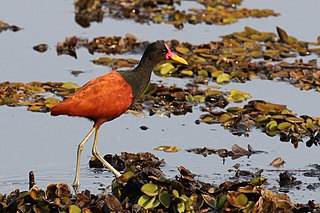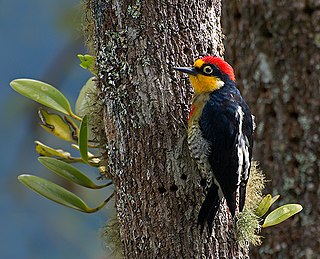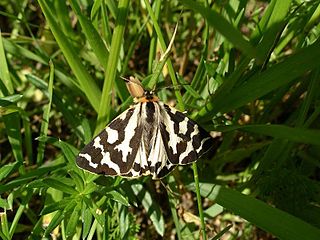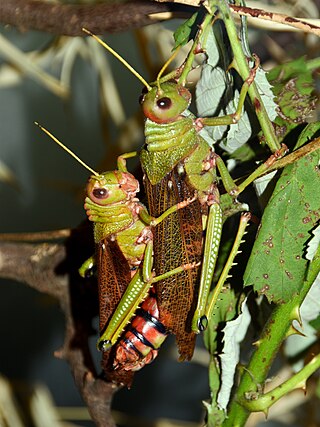
The wattled jacana is a wader in the family Jacanidae found throughout much of South America east of the Andes, as well as western Panama and Trinidad. It is the only species in the Jacanidae family with such a large distribution. Wattled jacanas have long toes and claws which help them walk through aquatic vegetation. Like the majority of species of jacanas, the female is larger than the male, and forms harems of up to 4 or 5 males at any given time. There is also a major difference in proportional development or ornamentation and defense relative to body size when compared to males.

The striped cuckoo is a near-passerine bird, the only member of the genus Tapera. This resident cuckoo is found from Mexico and Trinidad south to Bolivia and Argentina and Colombia.

Aposematism is the advertising by an animal, whether terrestrial or marine, to potential predators that it is not worth attacking or eating. This unprofitability may consist of any defenses which make the prey difficult to kill and eat, such as toxicity, venom, foul taste or smell, sharp spines, or aggressive nature. These advertising signals may take the form of conspicuous coloration, sounds, odours, or other perceivable characteristics. Aposematic signals are beneficial for both predator and prey, since both avoid potential harm.

Megacrania batesii, commonly known as the peppermint stick insect, is an unusual species of stick insect found in northeastern Australia, the Bismarck Archipelago, the Solomon Islands, New Guinea, and possibly as far north as the Philippines. It is notable for its aposematic coloration, as well as its robust chemical defense mechanism. Its common name refers to the irritating fluid — with an odor resembling peppermint — that it sprays as a defensive action from a pair of glands located at its prothorax when threatened, as well as the cylindrical, twig-like shape of its body. A member of the subfamily Megacraniinae, it was first described by English naturalist and explorer Henry Walter Bates in 1865.

The yellow-fronted woodpecker is a species of bird in the family Picidae. It is found in Brazil, Paraguay and far north-eastern Argentina. Its natural habitats are subtropical or tropical moist lowland forests and heavily degraded former forest. It is a fairly common bird with a wide range and the International Union for Conservation of Nature has classified its conservation status as "least concern".

Emsleyan mimicry, also called Mertensian mimicry, describes an unusual type of mimicry where a deadly prey mimics a less dangerous species.

Arctia plantaginis, the wood tiger, is a moth of the family Erebidae. Several subspecies are found in the Holarctic ecozone south to Anatolia, Transcaucasus, northern Iran, Kazakhstan, Mongolia, China, Korea and Japan. One subspecies is endemic to North America.

Dactylotum bicolor, also known as the rainbow grasshopper, painted grasshopper, or the barber pole grasshopper, is a species of grasshopper in the family Acrididae. It is native to the United States, Canada and northern Mexico and exhibits aposematism. It was first described by the German entomologist Toussaint de Charpentier in 1843.

Taeniopoda eques, the western horse lubber grasshopper, is a relatively large grasshopper species of the family Romaleidae found in arid and semi-arid parts of southwestern United States to central and southwestern Mexico. Most populations are identifiable by their shiny black bodies with contrasting yellow markings, but some adults are mostly yellowish, orangish or greenish. The species is unique in using its black coloration to thermoregulate and in being chemically defended. The aposematic coloration warns vertebrate predators of its unpalatability and allows the grasshopper to roost conspicuously upon shrubs.

Petasida ephippigera, the Leichhardt's grasshopper, is a relatively large, brightly coloured pyrgomorph species of grasshopper in the monotypic genus Petasida, native to the Top End region of tropical northern Australia.

Phymateus is a genus of fairly large grasshoppers of the family Pyrgomorphidae, native to shrubland, semi-deserts, savanna, woodland, gardens and cultivated areas in Sub-Saharan Africa, with ten species in the African mainland and two species in Madagascar. Some species have bright aposematic colours and are highly toxic.

Tropidacris collaris, the blue-winged grasshopper or violet-winged grasshopper, is a large South American species of grasshopper in the family Romaleidae. As suggested by its name, in flight the wings are usually conspicuously blue, but they can occasionally be grayish or greenish. Adult males are typically 5–7 cm (2.0–2.8 in) long and females typically 8.5–10.5 cm (3.3–4.1 in) long; the wingspan is usually about 18 cm (7 in). The gregarious and flightless nymphs are aposematically colored in black, red and yellow and are presumed to be toxic; a researcher who tasted one noted that it was very bitter, similar to a monarch butterfly.

Deimatic behaviour or startle display means any pattern of bluffing behaviour in an animal that lacks strong defences, such as suddenly displaying conspicuous eyespots, to scare off or momentarily distract a predator, thus giving the prey animal an opportunity to escape. The term deimatic or dymantic originates from the Greek δειματόω (deimatóo), meaning "to frighten".

Aularches miliaris is a grasshopper species of the monotypic genus Aularches, belonging to the family Pyrgomorphidae. A native of South and Southeast Asia, the bright warning colours of this fairly large grasshopper keep away predators and their defense when disturbed includes the ejection of a toxic foam.

Leptysma marginicollis, the cattail toothpick grasshopper or slender locust, is a species of grasshopper. It has a very pointed head and flattened, sword-shaped antennae. Thus, it superficially resembles grasshoppers in the subfamily Gomphocerinae, but is easily distinguished by the presence of a spur, or spine, between the front legs. They are usually brownish with a white, yellow, or brown stripe from the eye to the base of the front legs. The head is as long as, or longer than, the prothorax. On top, the body may also be red or pink. The front wings are sharply pointed, extending 3-5mm beyond the tip of the abdomen.

Tropidacris is a Neotropical genus of grasshopper in the family Romaleidae. They are among the largest grasshoppers in the world by length and wingspan, reaching up to 14.5 cm (5.7 in) and 24 cm (9.4 in) respectively. They are variably colored in green, brown, black, reddish or yellowish, and have wings that usually are conspicuously blue or red in flight. The gregarious and flightless nymphs have bright aposematic colors and are presumed to be toxic; a researcher who tasted one noted that it was very bitter, similar to a monarch butterfly.

Eyprepocnemis plorans, the lamenting grasshopper, is a species of insect in the family Acrididae. It is the type species of the genus Eyprepocnemis, and is found in Africa, parts of the Middle East, and southern Europe. It typically inhabits wetlands and other moist habitats.

Tropidacris cristata, the giant red-winged grasshopper, is a widespread species of lubber grasshopper in the family Romaleidae from tropical South and Central America, and Mexico. It is among the largest grasshoppers in the world by length and wingspan, reaching up to 14.5 cm (5.7 in) and 24 cm (9.4 in) respectively. More typical adult lengths are 5.5–7 cm (2.2–2.8 in), average 6.5 cm (2.6 in), in males and 7–12 cm (2.8–4.7 in), average 11 cm (4.3 in), in females. As suggested by the common name, adult T. cristata have conspicuously red wings in flight, although the exact red hue varies. The flightless and gregarious nymphs have aposematic dark-and-yellow stripes and are presumed to be toxic.
Onthophagus negligens, is a species of dung beetle found in India, and Sri Lanka.


















